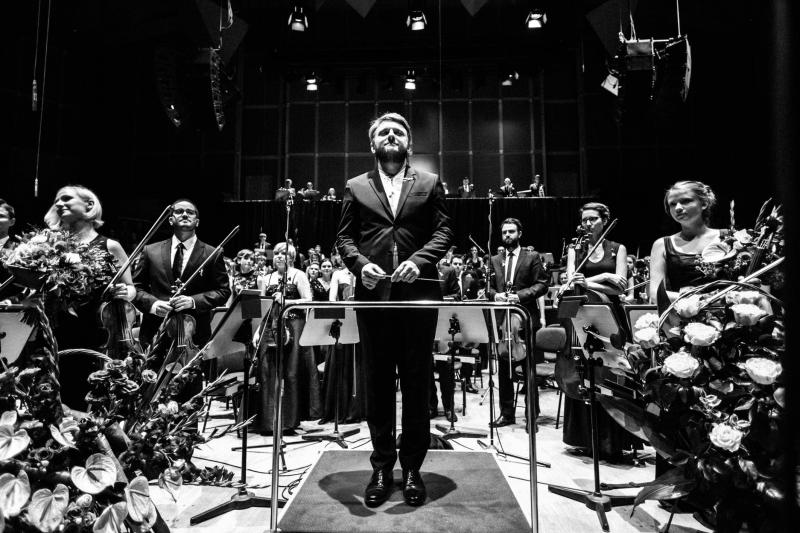I, CULTURE Orchestra, Karabits, Usher Hall, Edinburgh | reviews, news & interviews
I, CULTURE Orchestra, Karabits, Usher Hall, Edinburgh
I, CULTURE Orchestra, Karabits, Usher Hall, Edinburgh
Music trumps politics in youthful, even joyous Shostakovich 'Leningrad' Symphony

It is easy to be blinded by the sensational history of Shostakovich’s Seventh Symphony, the “Leningrad”. We cannot forget the famous performance by a starving makeshift orchestra in August 1942, at the height of the siege of Leningrad, or the dramatic way in which the Soviet authorities spirited the microfilmed score out of Russia to America via Tehran.
With the current political unrest and military instability on the Russian-Ukrainian frontier, one might expect that a performance of the 'Leningrad' by an Eastern European youth orchestra under the baton of the Ukrainian conductor Kirill Karabits would uncover contemporary resonances of its own, but this was an interpretation in which the music, first and last, spoke for itself, quietly, beautifully, and triumphantly. The I, CULTURE Orchestra, or ICO, was founded in Warsaw in 2011 and draws its players from Poland and the Eastern Partnership states: Armenia, Azerbaijan, Belarus, Georgia, Moldova, and Ukraine. For such a young band, with such young players, the sound is remarkably broad and unified, one or two cloudy brass entries the only discernible difference between this and more established ensembles.
 By any standards it is a huge orchestra, with a high proportion of female players, and the sheer volume of sound in this most noisy of symphonies was enough to impress the most cynical listener. From the first tentative rat-a-tat on the side drum, the Allegretto march grew steadily, inexorably, in power. But for those who seek evil in the unstoppable progress of this trite little tune (above, anti-aircraft machinery during the siege of Leningrad), there was none. With undemonstrative authority, Karabits allowed the music to unfold. The lower strings, whose role can be to rasp and unsettle, added depth and richness to the cacophony. The brass were not strident and militaristic but warm and biscuity.
By any standards it is a huge orchestra, with a high proportion of female players, and the sheer volume of sound in this most noisy of symphonies was enough to impress the most cynical listener. From the first tentative rat-a-tat on the side drum, the Allegretto march grew steadily, inexorably, in power. But for those who seek evil in the unstoppable progress of this trite little tune (above, anti-aircraft machinery during the siege of Leningrad), there was none. With undemonstrative authority, Karabits allowed the music to unfold. The lower strings, whose role can be to rasp and unsettle, added depth and richness to the cacophony. The brass were not strident and militaristic but warm and biscuity.
Much of the apparent naivety of the first movement’s themes is continued in the second, here performed with sweet innocence and charm that few performances achieve, or even attempt. The third movement, largely static, left space for contemplation, with a particularly lovely sound in a cantabile section for the large viola section.
As the symphony blazed its way to the affirmation of its conclusion it felt that a work so often marginalised by critics for its lack of emotional depth was here being celebrated for the simplicity and power of its music alone. It seemed inevitable that as the thud of the great bass drum marked the end, so the near-capacity audience should erupt with the most enthusiastic applause that I have yet heard this Edinburgh Festival, with each section of the orchestra as they were brought to their feet receiving ever louder accolades, particularly the young man on the side drum and the athletic young woman next to him on the timpani.
It would be easy to forget, in the wake of such a performance, the work that preceded it: the Sinfonia elegiaca by Andrzej Panufnik, who died in 1991. This too is a work that concerns itself with war, reflecting the composer’s bleak view that the sacrifice of war has done nothing to bring peace to the world. Spanning just 20 minutes in three linked movements, this is a simple and expressive work whose slow outer movements have something of an English flavour, with expansive but slightly bland harmonies, while the motoric central section speaks of the inhumanity of war with a rather polite vehemence. Any slight uncertainty that the players may have felt in interpreting this enigmatic piece was soon dispelled after the interval.
rating
Share this article
The future of Arts Journalism
You can stop theartsdesk.com closing!
We urgently need financing to survive. Our fundraising drive has thus far raised £49,000 but we need to reach £100,000 or we will be forced to close. Please contribute here: https://gofund.me/c3f6033d
And if you can forward this information to anyone who might assist, we’d be grateful.

Subscribe to theartsdesk.com
Thank you for continuing to read our work on theartsdesk.com. For unlimited access to every article in its entirety, including our archive of more than 15,000 pieces, we're asking for £5 per month or £40 per year. We feel it's a very good deal, and hope you do too.
To take a subscription now simply click here.
And if you're looking for that extra gift for a friend or family member, why not treat them to a theartsdesk.com gift subscription?
more Classical music
 Jansen, LSO, Pappano, Barbican review - profound and bracing emotional workouts
Great soloist, conductor and orchestra take Britten and Shostakovich to the edge
Jansen, LSO, Pappano, Barbican review - profound and bracing emotional workouts
Great soloist, conductor and orchestra take Britten and Shostakovich to the edge
 Jakub Hrůša and Friends in Concert, Royal Opera review - fleshcreep in two uneven halves
Bartók kept short, and a sprawling Dvořák choral ballad done as well as it could be
Jakub Hrůša and Friends in Concert, Royal Opera review - fleshcreep in two uneven halves
Bartók kept short, and a sprawling Dvořák choral ballad done as well as it could be
 Hadelich, BBC Philharmonic, Storgårds, Bridgewater Hall, Manchester review - youth, fate and pain
Prokofiev in the hands of a fine violinist has surely never sounded better
Hadelich, BBC Philharmonic, Storgårds, Bridgewater Hall, Manchester review - youth, fate and pain
Prokofiev in the hands of a fine violinist has surely never sounded better
 Monteverdi Choir, ORR, Heras-Casado, St Martin-in-the-Fields review - flames of joy and sorrow
First-rate soloists, choir and orchestra unite in a blazing Mozart Requiem
Monteverdi Choir, ORR, Heras-Casado, St Martin-in-the-Fields review - flames of joy and sorrow
First-rate soloists, choir and orchestra unite in a blazing Mozart Requiem
 Cho, LSO, Pappano, Barbican review - finely-focused stormy weather
Chameleonic Seong-Jin Cho is a match for the fine-tuning of the LSO’s Chief Conductor
Cho, LSO, Pappano, Barbican review - finely-focused stormy weather
Chameleonic Seong-Jin Cho is a match for the fine-tuning of the LSO’s Chief Conductor
 Classical CDs: Shrouds, silhouettes and superstition
Cello concertos, choral collections and a stunning tribute to a contemporary giant
Classical CDs: Shrouds, silhouettes and superstition
Cello concertos, choral collections and a stunning tribute to a contemporary giant
 Appl, Levickis, Wigmore Hall review - fun to the fore in cabaret and show songs
A relaxed evening of light-hearted fare, with the accordion offering unusual colours
Appl, Levickis, Wigmore Hall review - fun to the fore in cabaret and show songs
A relaxed evening of light-hearted fare, with the accordion offering unusual colours
 Lammermuir Festival 2025, Part 2 review - from the soaringly sublime to the zoologically ridiculous
Bigger than ever, and the quality remains astonishingly high
Lammermuir Festival 2025, Part 2 review - from the soaringly sublime to the zoologically ridiculous
Bigger than ever, and the quality remains astonishingly high
 BBC Proms: Ehnes, Sinfonia of London, Wilson review - aspects of love
Sensuous Ravel, and bittersweet Bernstein, on an amorous evening
BBC Proms: Ehnes, Sinfonia of London, Wilson review - aspects of love
Sensuous Ravel, and bittersweet Bernstein, on an amorous evening
 Presteigne Festival 2025 review - new music is centre stage in the Welsh Marches
Music by 30 living composers, with Eleanor Alberga topping the bill
Presteigne Festival 2025 review - new music is centre stage in the Welsh Marches
Music by 30 living composers, with Eleanor Alberga topping the bill
 Lammermuir Festival 2025 review - music with soul from the heart of East Lothian
Baroque splendour, and chamber-ensemble drama, amid history-haunted lands
Lammermuir Festival 2025 review - music with soul from the heart of East Lothian
Baroque splendour, and chamber-ensemble drama, amid history-haunted lands
 BBC Proms: Steinbacher, RPO, Petrenko / Sternath, BBCSO, Oramo review - double-bill mixed bag
Young pianist shines in Grieg but Bliss’s portentous cantata disappoints
BBC Proms: Steinbacher, RPO, Petrenko / Sternath, BBCSO, Oramo review - double-bill mixed bag
Young pianist shines in Grieg but Bliss’s portentous cantata disappoints

Add comment